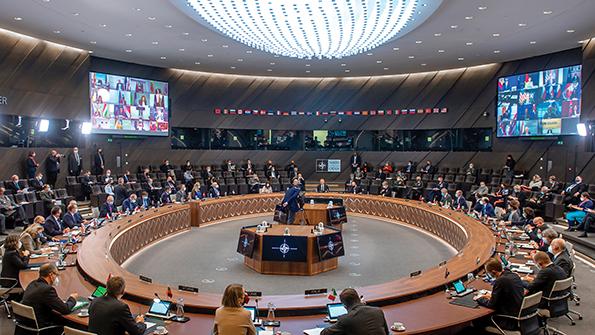
Major themes, opportunities and risks expected to shape the defense sector this year include outcomes of the fiscal 2022 and 2023 budgets for the U.S Defense Department, the U.S. midterm elections in November, supply chain issues and whether Pentagon reviews will say anything to affect defense market outlooks.
But other factors, some of which bubbled up in late 2021, could have more powerful and lasting effects than some of the budget, policy review and supply chain/pandemic issues Here are five worthy of consideration.
Russia’s troop buildup near its border with Ukraine might result in nothing much, and the U.S. and Iran could strike an agreement for the U.S. to rejoin the Joint Comprehensive Plan of Action. But either significant conventional conflict in Ukraine in 2022 or a complete breakdown in talks with Iran—or both—could reshape the defense outlook on several vectors profoundly.
If Russia uses conventional military force against Ukraine on a far larger scale than in 2014-15, there will be inevitable lessons to be learned from a conflict, depending on the effectiveness of opposing forces. Cyberwarfare could figure prominently, as could the use of drones, vulnerability of fixed sites to precision weapons and use of electronic warfare. The use of anti-armor weapons and loitering munitions could renew broader debates about how to protect expensive platforms.
A war in Ukraine also should affect European and U.S. defense posture and plans and reverberate through to Asia. Russia’s actions in 2014-15 led to increased European defense spending: Sweden’s defense budget, for example, has risen to $6 billion in 2021 from $4 billion in 2014, for example. Equipment ordered by Eastern and Central European states could see accelerated deliveries. The U.S. might be pressured to move military units back to Europe, and once again the Pentagon’s intent to focus on the Indo-Pacific region would be sidetracked.
A breakdown in negotiations with Iran could also elevate risk of a conflict, and that, too, will impart lessons on air and missile defense and possibly cyberdefense. It could drive other Middle East states to seek nuclear weapons and the capability to deliver them. Strikes against Iran’s nuclear sites still would leave it a significant security threat to the region, which could spawn defense demand from the Middle East.
A second theme related to conflict and geopolitics is how inflation and the global pandemic could raise new security concerns and instability. The civil disorder and protests in Kazakhstan that erupted in the first week of January after fuel prices were increased is one manifestation. Global food prices are at levels last seen a decade ago when the Arab Spring swept through the Middle East. Related to and compounding these stresses is the COVID-19 omicron variant. While vaccine rates are high in many developed countries, they are a fraction of those in many developing countries.
Turning back to defense in the U.S., there are three other issues to think through for 2022. One is whether the roots of disruption at the edges of the defense-industrial base become firmer and lead to challenges for established contractors—though some established contractors can be disruptors, too. Space and air-mobility segments see this theme is playing out. If General Motors wins another contract for the Joint Tactical Light Vehicle or Oshkosh/Hanwha is selected for further development of a new U.S. Army armored vehicle, either development could bring reassessments of the competitive landscape in defense.
Shareholder pressures and activist investors also may play a continued role in reshaping defense. Private-equity firms snapped up Cobham and Ultra in the UK and Cubic and Perspecta in the U.S. Activists have taken stakes in Comtech and Mercury Systems and are pushing for change at those companies. If defense stock prices continue to lag broader market indices, and institutional investors see relatively little of interest in the sector, financial actors could reshape the defense industry further.
A final issue to watch in the U.S. is whether anything comes of President Joe Biden’s executive order issued July 9, 2021, titled “Promoting Competition in the American Economy.” That order included a request that the Defense Department submit to the White House Competition Council a review of competition within the defense-industrial base as well as a report on the Pentagon plan to effectively avoid “vendor-lock,” where it was precluded from servicing or repairing equipment, “particularly in the field.”





